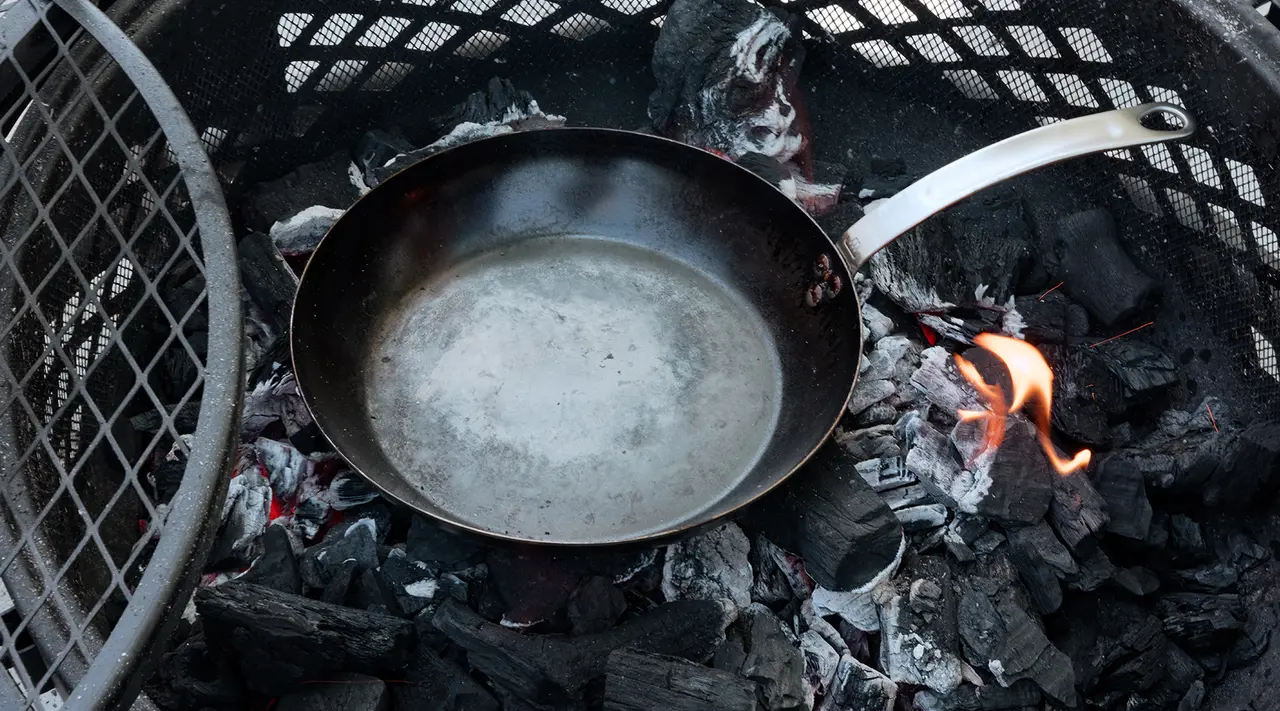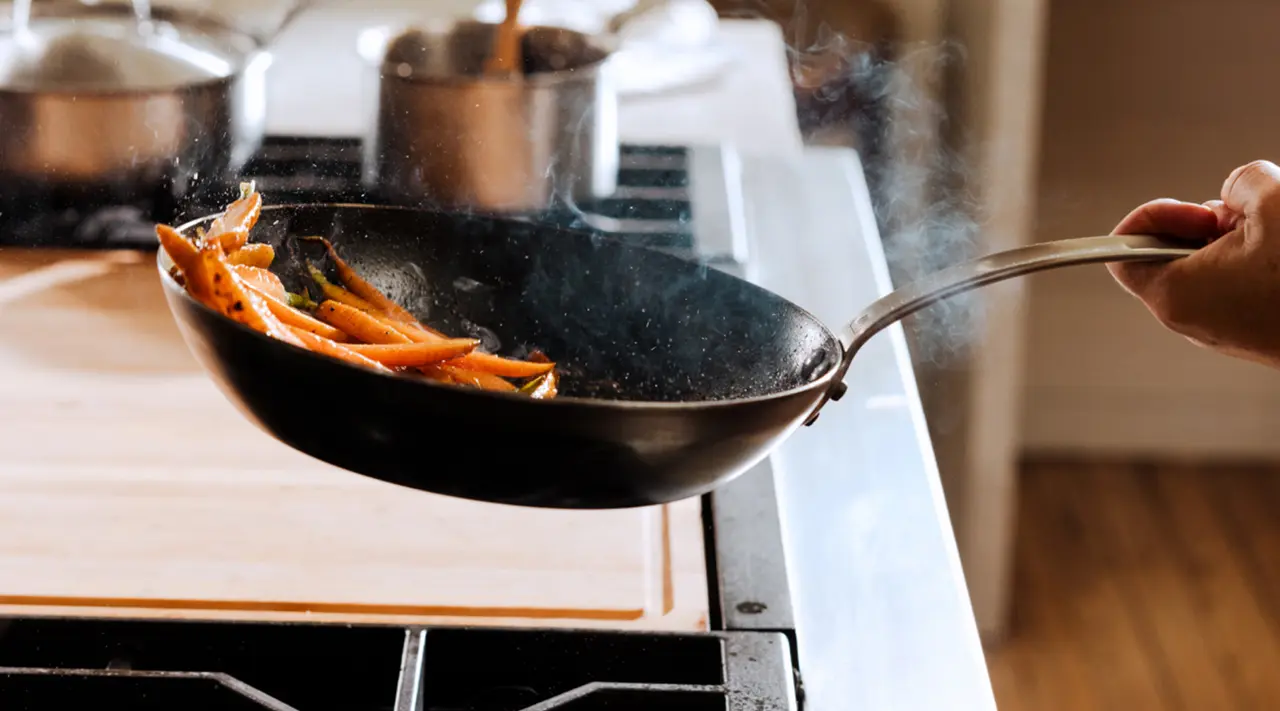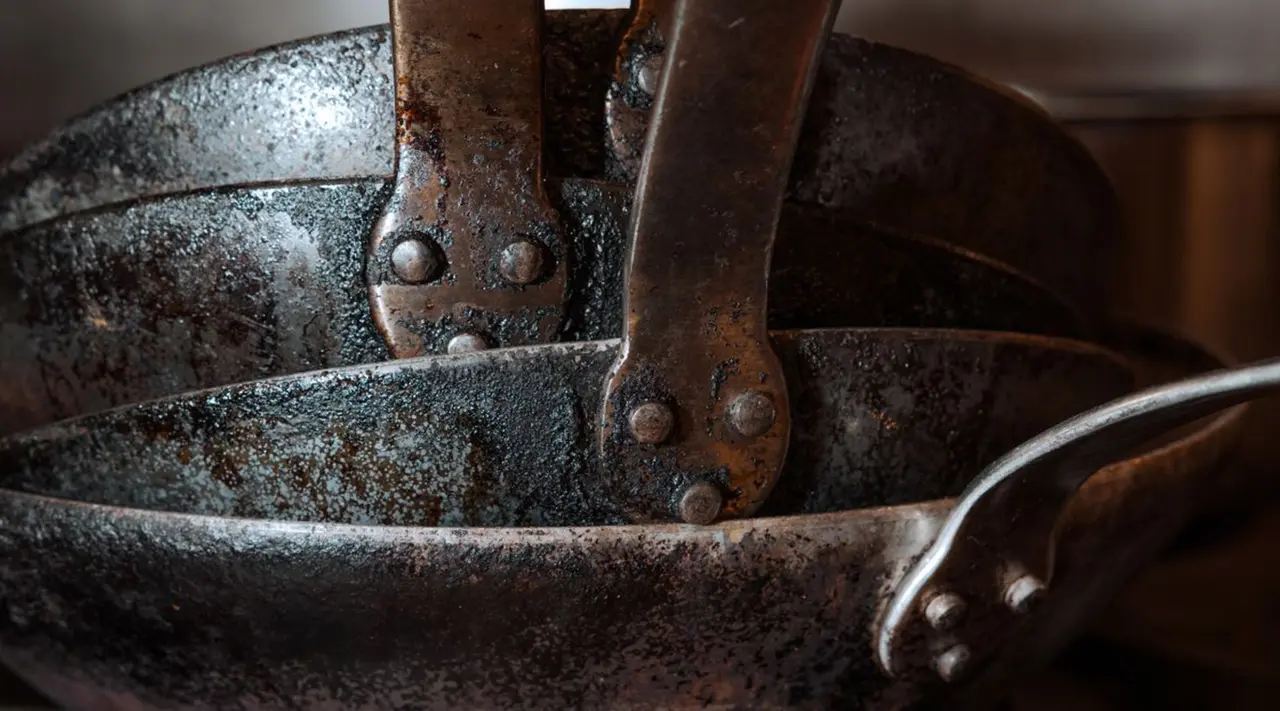One of carbon steel’s main selling points is its beautifully smooth, naturally non stick seasoning, created by coating your pan with a high smoke-point oil and heating it to form a protective layer. Cooking fatty foods—like bacon, steak, or burgers—builds upon that initial seasoning until you can cook even the most delicate eggs or fish without sticking.
While the seasoning process is fairly straightforward, it’s also easy to mess up down the road (especially if you’re new to it—speaking from experience). You may accidentally scrub your pan a little too hard; cook a particularly oily, messy meal that’s nigh impossible to clean up; or allow it to rust.
Before you panic and toss it in the trash, though, remember: carbon steel is virtually indestructible. In fact, you can easily restore it to its former non stick glory, using a process called stripping. Here’s how—and when—to do it.
Why (and When) Stripping Carbon Steel Is Necessary

Like a controlled forest fire, sometimes the best path forward is to burn it all down (in this case, strip it all down) before you can make it better. Stripping your carbon steel pan removes every layer of polymerized oil, leaving you with, essentially, a bare metal canvas upon which you can rebuild your seasoning.
It can feel a bit painful at first to wash away all your hard-earned seasoning, but it’s definitely necessary—especially in these specific instances:
- Your pan has been seasoned unevenly or excessively, leaving you with a patchy and/or sticky surface;
- You’ve got a stubborn, burnt-on mess that’s impossible to remove without ruining your seasoning;
- Your pan is rusty.
How to Strip a Carbon Steel Pan

To properly strip your pan, you’ll need dish soap, a strong cleaning agent like vinegar or baking soda, plus a steel wool scouring pad, brush, or other coarse scrubber. A paper towel or dishcloth is useful for wiping your pan dry, and gloves can keep your hands safe from irritation while you scrub.
Read on for step-by step instructions, or follow along with the above example of restoring a rusty carbon steel skillet.
Step 1: Clean the Pan
Get your pan as clean as possible with some dish soap and warm water, making sure to hit the outside and handle.
Step 2: Apply the Cleaning Agent
Fill your sink or a large tub with a 50/50 mixture of water and white vinegar—enough to fully submerge your pan. Allow to soak for 30 minutes, then remove it from the soaking liquid and give it a scrub with soap and water.
Step 3: Scrub the Pan
There will probably still be some rust or burnt oil leftover: make a paste by sprinkling a small amount of baking soda to the pan, then adding vinegar until it becomes a thick but spreadable paste. The mixture should foam up as the acid and base interact.
Use your scrubber to scour the entire pan—inside and outside— until you see the raw, silver metal peeking through. Keep scrubbing until the entire pan is thoroughly stripped and any rust or residual seasoning is gone.
Step 4: Rinse and Dry
Rinse your pan and then dry thoroughly before starting the re-seasoning process—any water trapped beneath the layers of seasoning can also lead to rust or unevenly applied seasoning.
Step 5: Season
The re-seasoning process is exactly the same as the initial seasoning process: you’ll need a small amount of neutral, high-smoke point oil (just a few drops—too much oil can create a sticky seasoning layer) and a hot oven. Here’s our full guide to re-seasoning.
Carbon Steel Maintenance Tips

Knowing how to clean, season, and otherwise maintain your carbon steel cookware can help save you the hassle of stripping and re-seasoning it all the time—not to mention, a well-maintained pan will perform way better than a neglected one.
Season After Stripping
This is very important: once your pan is fully stripped, it’s extra vulnerable to the elements and can start to rust if it’s not re-seasoned right away. Otherwise, you’ll just have to start the entire process over again. Here’s our seasoning guide again, in case you missed it.
After seasoning, we suggest cooking high-fat foods—like bacon, ground beef, or steak—for the first several uses to continue building the initial seasoning layer up.
Follow Regular Cleaning Practices
Make sure you’re cleaning your pan properly after every single use, and never allow it to soak or sit overnight without drying it (which leads to rust). For more minor, everyday messes, all you need is a bit of water and a quick wipe with a dish towel. If you’ve got stuck-on food or burnt oil that won’t come off with water alone, try using one of the methods outlined in our carbon steel cleaning guide.
Know When to Re-Season
As we’ve touched on, there are a few ways to tell when your pan needs a seasoning overhaul.
- Patches of shiny, raw metal are starting to show through seasoning layers (typically happens when seasoning is applied unevenly);
- Your pan is visibly rusty or covered in caked-on food or grease;
- Food that once flipped without issue is starting to stick to the surface.
Ready to Cook?
Stripping your carbon steel pan can feel a bit like admitting defeat, especially after all the time you spent building up your seasoning. But that’s the beauty of this resilient, durable material: while traditional coated pans need to be treated with a gentle touch in order to preserve their coating, our Carbon Steel can put up with a lot. And if you use your pan as often as we do (i.e. on the daily), that’s pretty excellent news.

































